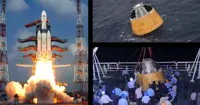ISRO conducts 'hot test' on cryogenic engine
20 Dec 2008
Bangalore: On the back of the launch of unmanned moon mission Chandrayaan-I last month, Indian Space Research Organisation (ISRO) has now reported having successfully conducted the flight acceptance ''hot test'' of its indigenous cryogenic (supercooled fuel) engine.
Cryogenic engines are rocket motors designed for liquid fuels that have to be held at very low 'cryogenic' temperatures, as they would otherwise be gas at normal temperatures. ISRO will use this engine to power the next geosynchronous launch vehicle (GSLV-D3) mission.
The space research agency said in a statement, "The flight acceptance hot test of the Cryogenic engine was carried out at the liquid propulsion systems centre at Mahendragiri in Tamil Nadu Thursday. This engine will be used in the next GSLV launch in April 2009 for carrying the 2.3-tonne geo-stationary experimental satellite (GSAT).''
Cryogenic engines typically use, hydrogen and oxygen, which need to be held respectively below 20 degrees Kelvin (-253 degrees Celsius) and 90 degrees Kelvin (-183 degrees Celsius) to remain in liquid form.
ISRO plans to use its own first cryogenic engine in place of the Russian-made engine in the upper stage of the rocket that will deploy the satellite with navigation and technology payloads into the geosynchronous transfer orbit (GTO).
The cryogenic engine develops a thrust of 73 kilo Newtons (kN) in vacuum with a specific impulse of 454 seconds (7.56 minutes) and can carry 2.2 tonnes.
Working on a staged combustion cycle with an integrated turbo-pump, the engine will have 42,000 rotations per minute (rpm). It also has two steering engines developing a thrust of 2 kN each to enable three-axis control of the launch vehicle during the flight mission.
'The hot test was carried out for 200 seconds (3.33 minutes) during which the engine was operated in the nominal and 13 percent up-rated thrust regimes. All the propulsion parameters were satisfactory and matched with predictions,' the statement mentioned.
The cryogenic engine will be integrated with propellant tanks, stage structures and associated feed lines of the launch vehicle for the flight mission in April next from the spaceport at Sriharikota, about 80 km north of Chennai.
The central government Friday approved the development of semi-cryogenic engines for space transportation at a cost of Rs.1,798 crore (approx Rs.18 billion) with a foreign exchange component of Rs.588 crore (Rs.5.88 billion).
'This will be an important step towards self-reliance in advanced space transportation technology,' Home Minister P. Chidambaram told reporters in New Delhi.
Cryogenic engine technology is currently present only in Russia and the US.
The semi-cryogenic engines will facilitate applications for future space missions like the reusable launch vehicle, the unified launch vehicle and the vehicle for inter-planetary missions, Chidambaram added.






.webp)

.webp)






















